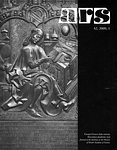
Journal ARS 42 (2009) 1
Zsófia KISS-SZEMÁN
Výtvarná diskusia o tvorbe Antona Jaszuscha v roku 1924. „Mravné popravenie jedného Slováka“ alebo „gigantická práca a tvorba jedného slovenského umelca“[Artistic Discussion about the Work of Anton Jaszusch in 1924. “Moral Execution of a Slovak Man” or “Gigantic Work of a Slovak Artist”]
(Summary)
Richly layered and marked out by a few periods is the more than a half-century lasting creation of Anton/Antal Jaszusch (1882 – 1965), which belongs among the top fine art manifestations of the 20th century in Slovakia.
Jaszusch was inspired by postimpressionist premises and character of the creation before World War I was set mainly by the painter’s interest in problems exclusively in fine art, mainly about the relation of space and a line but also his interest in the unusual, sensed through the painter – it means not natural colour-scheme in painting. As a result Jaszusch created his personally understood painter’s expression, comprised of art deco segments, fed mainly by the art of two-dimensional decor and reminiscences of plain-air and impressionistic painting.
World War I – the painter survived first the Italian and Russian front, later prisoner of war camps in the Far East from where he belatedly, only in 1920, returned home to Košice/Kassa/Kaschau – shook up Jaszusch’s spiritual world, it changed in a subsistent way his thinking, internal persuasion together with his mission as a painter and his artistic program: in the years 1920 – 1924 he created a large collection of thematic paintings concerning existential questions of man, meaning of life and a man’s place on Earth and also in the Universe as well as of the character and also ethical mission of a man. Jaszusch’s humongous spiritual upswing found a suitable medium for intercession of great thoughts in generously composed expressively dynamic, poetic pictures with the idea about gigantic effort of humans to find their dignified place in the universe.
The basic idea of the paintings locally appears in a satiric or ironic formulating of the theme or in picturing of scenes with didactic, moral-educational sub text, other times as a picture of visions of natural or historical, social catastrophes. Cyclically composed ensemble of 10 paintings with dimensions almost 3 × 3 metres (!) is directed by themes of cosmos, history of cosmos and the story of man (Termination of the planet, Flood, Life of a man, Spring of life, Tragedy of a man), including the history of humans (War, Revolution, Golgotha), ends with the Last judgement, after which sets in merger and harmony of the universe and a man (Migration of souls).
Painting style of Anton Jaszusch in the 1920s century presents the painters view, which is determined mainly by personal survival. After the events of World War I, Jaszusch could not consider art to be only a form of personal expression, but he had to understand it as an answer for existential questions and also a possibility to find his own identity.
The art of Jaszusch was concerned with many, often until now actual and also tabooed themes. Universalism and spirituality in art, its supranational or European character was not and even today is not a certainty. Art, which was asking these questions, like appearing of new themes in a new spirit and in a new way in art, further real and a fictive place and role of an artist and his mission in society, fashion and imitating or approval of non-traditional capturing of the world of pictures, with its actuality it caused until then unseen response and it is a prove of an immense daring, involved and innovatory way of Jaszusch’s thinking.
English translation by A. Antalová